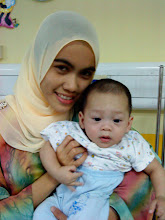Just revising on Acute lymphoblastic leukaemia, based on teaching with Prof Tang & seminar w Prof Hamidah, as well as Lissauer & Clayden.
For the first time, i think leukaemia is quite simple n easy (for my level).
************************************************
Childhood malignancy is rare, but if occurred, the most common is leukaemia.
CLASSIFICATION of LEUKAEMIA:
1. Acute
HIGH RISK group:
means that, this group of patient require high/prolonged therapy n poor prognosis
1. Age: <>10years old
2. White cell count > 50 x 10^9
3. Male
4. CNS involvement
: CNS 1 = negative for blast cell --> no risk/ normal
: CNS 2 = CSF WBC < 5 no risk, but can be high risk in certain condition
: CNS 3 (CNS diasease) = CSF WBC >5, cytospin +ve for blast blast cell--> high risk
5. Translocation (cytogenetics)
: Philadelphia t(9,22)
: MLL gene rearrangement.
*regarding the MLL gene rearrangement*
- more common in infant.
- only 5% in children.
- so, what is the significant if cytogenetic is POSITIVE:
-----> indicator of response to therapy.
To monitor response, we do Bone marrow aspiration and trephine biopsy.
then do cytogenetic analysis. If there's presence of those chromosomal load of Ph/ MLL means that the blast cells still there, means that therapy is inadequate. (because those Ph/ MLL is in the blast cells)
If the load is reducing then disappear (from Positive to Negative) means they respond to treatment.
CLINICAL FEATURES:

************************************************
Childhood malignancy is rare, but if occurred, the most common is leukaemia.
CLASSIFICATION of LEUKAEMIA:
1. Acute
- Lymphoblastic
- Myeloid
- Lymphoblastic
- Myeloid
- Chemical exposure : benzene, smokes
- Radiation exposure
- Chromosomal abnormalities - Down's, neurofibromatosis
- Infection - human T-lymphocytic virus (HTLV), EBV
HIGH RISK group:
means that, this group of patient require high/prolonged therapy n poor prognosis
1. Age: <>10years old
2. White cell count > 50 x 10^9
3. Male
4. CNS involvement
: CNS 1 = negative for blast cell --> no risk/ normal
: CNS 2 = CSF WBC < 5 no risk, but can be high risk in certain condition
: CNS 3 (CNS diasease) = CSF WBC >5, cytospin +ve for blast blast cell--> high risk
5. Translocation (cytogenetics)
: Philadelphia t(9,22)
: MLL gene rearrangement.
*regarding the MLL gene rearrangement*
- more common in infant.
- only 5% in children.
- so, what is the significant if cytogenetic is POSITIVE:
-----> indicator of response to therapy.
To monitor response, we do Bone marrow aspiration and trephine biopsy.
then do cytogenetic analysis. If there's presence of those chromosomal load of Ph/ MLL means that the blast cells still there, means that therapy is inadequate. (because those Ph/ MLL is in the blast cells)
If the load is reducing then disappear (from Positive to Negative) means they respond to treatment.
CLINICAL FEATURES:

INVESTIGATION:
1. Full blood count
> high/normal/ low total white cell count
> anemia (normochromic normocytic)
> thrombocytopenia
> lymphocytosis
2. Peripheral blood film
> blast cells (based on FAB classification, it is further divided into L1, L2, L3)
3. Bone marrow aspiration , trephine biopsy
> if presence of more than 30% of blast cells
4. Lumbar puncture
5. Cytogenetic analysis
6. Immunophenotyping
7. Liver function test
8. Renal profile
9. LDH
10. Coagulation profile
11. Infection screening
*For diagnosis.
*Done as a baseline prior to do chemotherapy.
7. Liver function test
8. Renal profile
9. LDH
10. Coagulation profile
11. Infection screening
*For diagnosis.
*Done as a baseline prior to do chemotherapy.
MANAGEMENT:
1. Chemotherapy
- Remission induction
- Intensification/ consolidation
- CNS prophylaxis
- Maintenance
2. Marrow transplant
COMPLICATION OF CHEMOTHERAPY:
1. Acute
2. Chronic
(cari sendiri la hehe)
Tumor Lysis Syndrome
One of the malignancy emergency.
it can occur even before chemotherapy, as well as after chemo.
It occurs due to high rate of cellc turnover, giving a characteristic of:
- hyperuricemia
- hyperkalemia
- hyperphosphataemia
- hypocalcemia
************************************************************
the presentation of patient with leukaemia is more or less the same. Kalau nak cari jugak bezanya, cari sendiri. And kalau ada apa2 yg saya tersalah cakap kat atas ni, correct me, OK
p/s: Stadi. stadi, jap lagi nak keluar rewardkan diri sebab stadi pagi ni heheh




0 comments:
Post a Comment